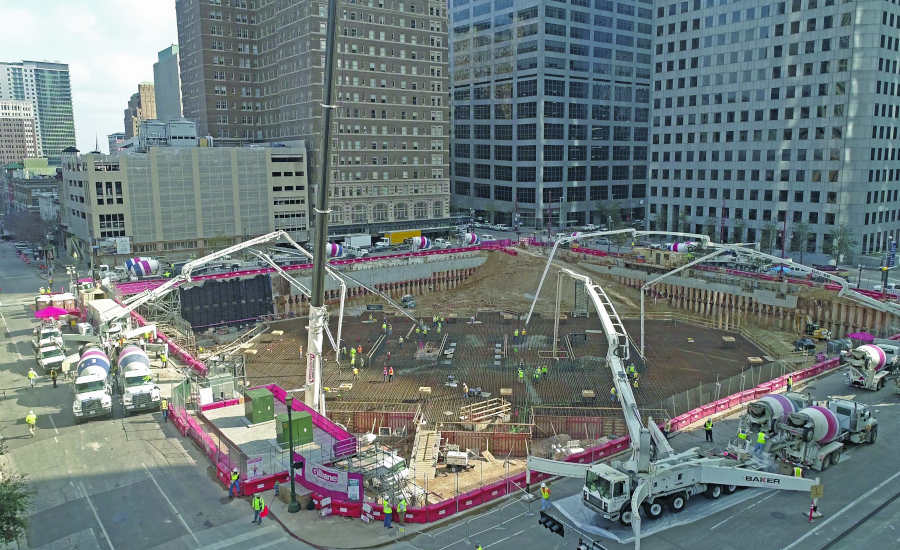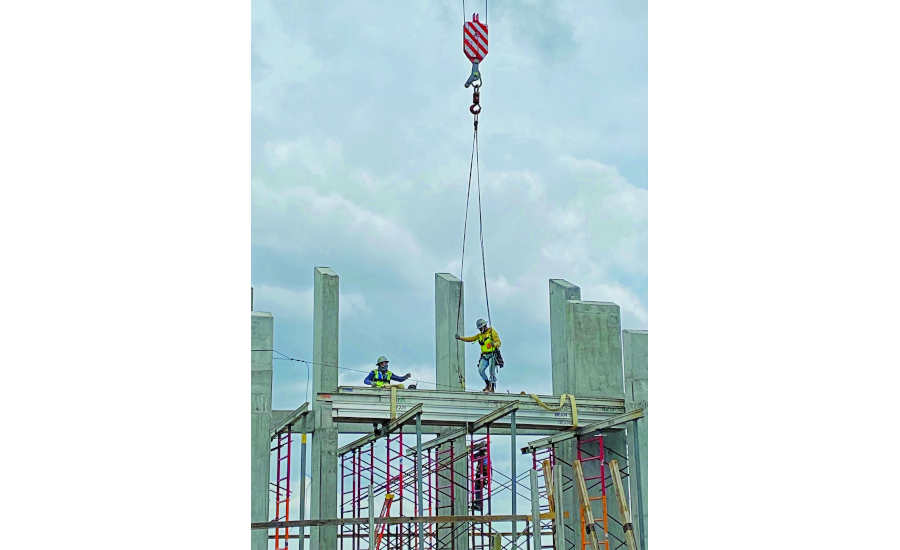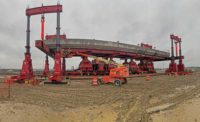An addition to downtown Houston’s skyline is nearing completion as crews overcome difficulties that came with building one of the city’s heaviest towers on the site of the former Houston Chronicle building.
Texas Tower is a 47-floor, 1-million-sq-ft Class AA office tower on the 800 block of Texas Avenue. Pelli Clarke Pelli and Kendall-Heaton are leading the design, and Gilbane Building Co. is serving as general contractor on the construction manager at-risk project for clients Hines and Ivanhoé Cambridge. This tower is being built to the highest standards Hines has ever developed in Houston, seeking LEED Platinum and Silver under the International WELL Building Institute’s WELL Standard.
Features include office spaces, a 672,000-sq-ft aboveand below-grade parking structure and underground tunnel connections. In addition, 10-ft, full-height windows will allow for an abundance of natural light across the 30,000-sq-ft floor plates, says Larry McCarty, vice president of construction at Hines.
“Hines streamlined the selection process and provided a notice to proceed the day after notice of award.”
—Alan Coleman, Project Manager, Gilbane
“Cantilevered bays on each face of the floorplate are surrounded by three walls of glass providing opportunities for dramatic internal stairs, atriums and communal spaces as well as potential access to fresh air and outdoor green space,” McCarty says. “Additionally, the tower is placed diagonally on the site, resulting in unique, more interesting view angles and a powerful civic presence.”
Following the demolition of the old Houston Chronicle building at this location in 2017, Hines envisioned utilizing the site for a future commercial high-rise once the right opportunity presented itself, explains Alan Coleman, project manager with Gilbane. That opportunity came in early 2018 when Hines secured an anchor tenant.
“It is well positioned on the prow of the Houston skyline, directly adjacent to the Arts District, Market Square and the Buffalo Bayou,” adds Edward Dionne, principal at Pelli Clarke Pelli. “And with the success of several residential tower developments nearby, this block had all the markings of being the centerpiece of a vibrant live-work-play neighborhood in the heart of downtown.”
Design began in late 2017. The ownership team issued requests for proposals from general contractors and an “A” group of subcontractors based on “very preliminary design development drawings,” McCarty explains. Gilbane was awarded the project in June 2018, and Hines provided a short list of that “A” group of subcontractors. “We then partnered with all of them to finalize the design and finalize our final guaranteed maximum price for the building,” he says, which followed in December 2018.
Coleman recalls the early phases of the project moving “lightning fast” to make challenging completion dates. “Hines streamlined the selection process and provided a notice to proceed the day after notice of award,” he says.

PLACEMENT TIME: The structure’s 12-ft thick, 14,000-cu-yd concrete mat foundation placement took place over 22 continuous hours. Concrete pump trucks are seen here placing the concrete over 1,800 tons of steel reinforcing, mostly consisting of 60-ft-long No. 18 bars.
FROM THE GROUND UP
Dionne says the design team was tasked with two goals: maximizing opportunities to connect tenants to outdoor spaces and ensuring that the ground floor lobby was “highly activated by direct connections to retail and amenities to become a vibrant extension of the office space.”
One way the team accomplished this was by turning the tower diagonally above the podium, which created “three large roof terraces atop the garage instead of one. It also orients the lobby such that it is enveloped by retail and opportunities for pedestrian scaled amenity,” Dionne says.
The “twist” also gives “typical tower floors a longer glazed perimeter and featured bump-out viewpoints along a diagonal across the skyline,” adds Coleman.
To free up the ground floor for amenities and to protect utilities from potential damage in future floods, Texas Tower’s large utility vaults were relocated from the ground to the top of the parking garage, Dionne says.
“Excluding the foundations and shoring system, the building superstructure weighs approximately 190,000 tons.”
—Matthew W. Streid, Senior Associate, Magnusson Klemencic Associates
In total, 16,725 sq ft of building services were relocated, including a 4,600-sq-ft chiller plant, a 3,100-sq-ft electrical vault, a 3,025-sq-ft main electrical switch gear and a 1,075-sq-ft emergency generator.
The site had several buildings dating back to the early 1900s. The team faced numerous logistical challenges given the existing footprints and depths, McCarty says.
“In order to do our mass excavation on the property, we had to install our retention system, which consisted of a mixture of soldier piles around the shallow existing foundations and tiebacks through the old foundation walls at the deeper sections,” he says.
The footprint extends from curb to curb on a full city block, bordered by some of the most heavily traveled roadways in downtown Houston, notes Coleman.
“We were very limited with our permissions to close lanes, which made excavation a real challenge,” he adds. Because excavation limits extended into the street, the project team worked closely together on a phased excavation approach that “would not compromise the integrity of the adjacent roads.”
Moreover, downtown Houston has a system of tunnels, located about 20 ft deep and spanning more than six miles, connecting 95 city blocks. The existing Chronicle Tunnel spanned 650 ft along Milam, Texas and Travis streets at depths ranging between 9 ft and 31 ft beneath the surface, Coleman says. “Our construction operation included the complete demolition of the existing tunnel system within the Block 58 building footprint,” he says.
Before demolition work began on the tunnel, the structure of in-place tunnel sections had provided lateral support for the existing foundation walls, which prevents the downtown Houston streets from collapsing, Coleman says. In order to ensure the continued integrity of these walls, the contractor sequenced the demolition so the foundation tiebacks, drilled piers and structural bracing were in place prior to removing critical portions of tunnel.
The tunnel replacement was also built on a separate schedule from the tower.
“Our tunnel sits directly beneath a portion of the buck hoist,” says Coleman. “We had to get creative to position the buck hoists such that pedestrians would never be positioned beneath the cars. We built a two-hour rated separation between the tunnel and the adjacent garage basement levels; we invited the fire marshal and local fire department to help develop our life safety egress plan and emergency protocols; and we worked closely with neighboring buildings to tie into their infrastructure for utilities and life safety.”
Another factor was the potential for catastrophic flooding. “Given the depth of this system, the tunnel was designed to withstand such a flood event. Each building connection to the tunnel has been designed with a manufactured flood door, which will withstand the pressures of rising water in the event of a flood,” Coleman says. “The typical subsurface water will be addressed with a perimeter trench system that collects any ground water migrating through the foundation walls and pumps it out.”
The replacement tunnel’s phased build-back opened in 2019 and took less than six months, McCarty says.
Texas Tower is one of the heaviest towers ever constructed in downtown Houston, says Rudolph P. Frizzi, managing principal and executive vice president at Langan, geotechnical consultant on the project.
“Excluding the foundations and shoring system, the building superstructure weighs approximately 190,000 tons,” adds Matthew W. Streid, senior associate with structural engineer Magnusson Klemencic Associates (MKA). Streid says lightweight concrete was used for all horizontal gravity framing to reduce building weight as much as possible.

LOOKING DOWNTOWN: The view from Level 47 at the skylight area prior to the start of tenant improvements in the lease space.
TOWER SUPPORT
MKA and Langan staff engineered the building to take into account both the differential settlement expected over time for the 12-ft-thick concrete mat foundation and the axial shortening anticipated to occur at the tower’s perimeter concrete columns throughout the two-year construction of the concrete structural frame, explains Matteo Alibrio, Gilbane senior project manager. The team also developed iterative soil-structure modeling and interaction to estimate total and differential settlements as the tower is constructed, Frizzi says.
“Historic foundation selective demolition, removal, replacement and multiple below-grade parking structure mass excavation was coordinated with new tower mat and podium shallow foundation construction,” he says. “The temporary excavation support system integrated the former structure’s below-grade walls to minimize the extent of required new walls.”
To maximize the efficiency of the concrete core and reduce demands at the mat foundation, a concrete wall outrigger system at Level 12 engages the perimeter columns and increases the building’s stance, Frizzi adds.
“To further economize the concrete core, the post-tensioned girders at each floor were utilized as micro-outriggers to further engage the perimeter columns,” Streid says. The team performed a detailed analysis in coordination with the construction sequence in order to anticipate building movement through construction, he says.
“Elastic shortening and long-term creep of the concrete, in combination with the anticipated differential settlement, required a rigorous surveying and monitoring program,” Streid says. “The surveying program allowed the design team to provide adjustments to concrete elevations as necessary to maintain correlation with the anticipated movement and deliver the structure at design elevations.”
For the foundation, crews installed 3 million lb of rebar across the 1.8-acre site in 28 days. Then over the course of 22 hours on a Saturday in March 2019, a team of 120 workers placed 14,000 cu yd of structural concrete using six pumper trucks and 1,400 concrete trucks.

WORK IN THE AIR: Concrete crews working more than 700 ft above street level assemble scaffolding to allow work on the tower’s crown to continue.
KEEPING PACE
Schedule has been a major challenge. The team had to top out the concrete structure of the tower on time so that the top seven office levels could be completed to a point that would allow build-out work to begin immediately for one of the primary anchor tenants, which had a critical completion deadline for their move-in, Alibrio says.
“Gilbane and our trade partners collaborated on creative approaches to improving our structure schedule including a climbing shear wall system, pour splits and vertical pumping systems,” Coleman says. On March 22, the project team celebrated Texas Tower’s topping out more than a month ahead of schedule.
The tower features 100% raised access floating floors, McCarty says. “By raising the floor a foot above the base of the actual floor level, air is fed from under the floor to cool the building. By reducing the velocity, it increases efficiency, lowers cost and allows individual users to adjust the air flow and temperature around their immediate space.”
This system is versatile in terms of tenant flexibility because “the entire underfloor plenum is a pressurized air system,” Coleman adds. “The challenge with the installation of this type of system is ensuring the pressurized plenum is tight [and] does not leak air.”
“We had to pivot and change manufacturers a couple of times ... to ensure we received materials on time.”
—Larry McCarty, Vice President of Construction, Hines
Gilbane worked with its trade partners to mock up a full floor of the access panels for testing, then enlisted a third-party testing agent to determine the air leakage in a pressurized condition, Coleman explains.
“Once we had successfully demonstrating the air tightness of the air plenum, we implemented a dedicated underfloor inspection procedure, which has been utilized for each subsequent floor,” he adds.
Rainwater management on the elevated decks became an interesting challenge, Alibrio says.
“During construction of the tower’s superstructure, greater differential settlement was expected to occur at the tower floor perimeter columns versus the thick reinforced concrete shear walls located in the core of the floor plates,” he says. “To overcome this, the perimeter columns and floor decks were poured higher at the perimeter of the floors to allow them to settle over time to eventually be even with the floor deck at the core.”
This created a ‘funnel effect,’ which meant that whenever it rained, water would travel to the core of the floors where most of the deck openings for elevators, stairs and MEP risers were located, Alibrio says.
“To overcome this issue, we built concrete curbs or special waterproofed angle dams around floor openings such as stairwells and MEP riser shaft openings located within the core of building,” he says. “We built temporary drains and also built temporary drycaps at designated levels to help keep the floors beneath them dry.”
To help ensure accuracy throughout the project, Gilbane used SiteAware’s proprietary Digital Construction Verification Platform, Alibrio says. Also, with the project’s lofty sustainability goals in mind, the team recently committed to using TrueCarbon software to track the carbon impact of the construction process at Texas Tower.
The team also 3D modeled the entire project, printing a large-scale model that sat on a conference room table.
“We utilized this printed model daily when coordinating phasing for the construction, schemes for balconies and for overall orientation in planning discussions,” Coleman says.

CRANING VIEW: North and south tower cranes illuminate the live deck as work winds down for the day. The large Level 12 public terrace planter walls are visible as are several of the towers private terraces.
PANDEMIC IMPACTS
Sourcing materials became difficult as a result of the pandemic, but it was more so for domestic suppliers, given that so many states were shutting down and going into quarantine, McCarty says. “We had to pivot and change manufacturers a couple of times to accommodate our schedule to ensure we received materials on time and could continue our progress,” he says.
Stone, tile, elevators and the building maintenance unit were sourced internationally, Alibrio says. “The marble stone that clads the main lobby is being quarried from Monte Altissimo, the same mountain quarry that Michelangelo discovered in 1517,” he says.
Gilbane follows a “playbook” that the company developed to ensure consistency in safe working practices, along with recommendations from the CDC, Alibrio says. “It was encouraging to hear workers tell us that they felt safer at the jobsite than at their own homes because of all of the measures that were put in place,” he says.
As of mid-April 2021, crews have completed approximately 1.4 million worker hours— with about 400 workers on site daily—with a recordable incident rate just above 1.00. Construction is about 85% complete, and completion is on track for October.




